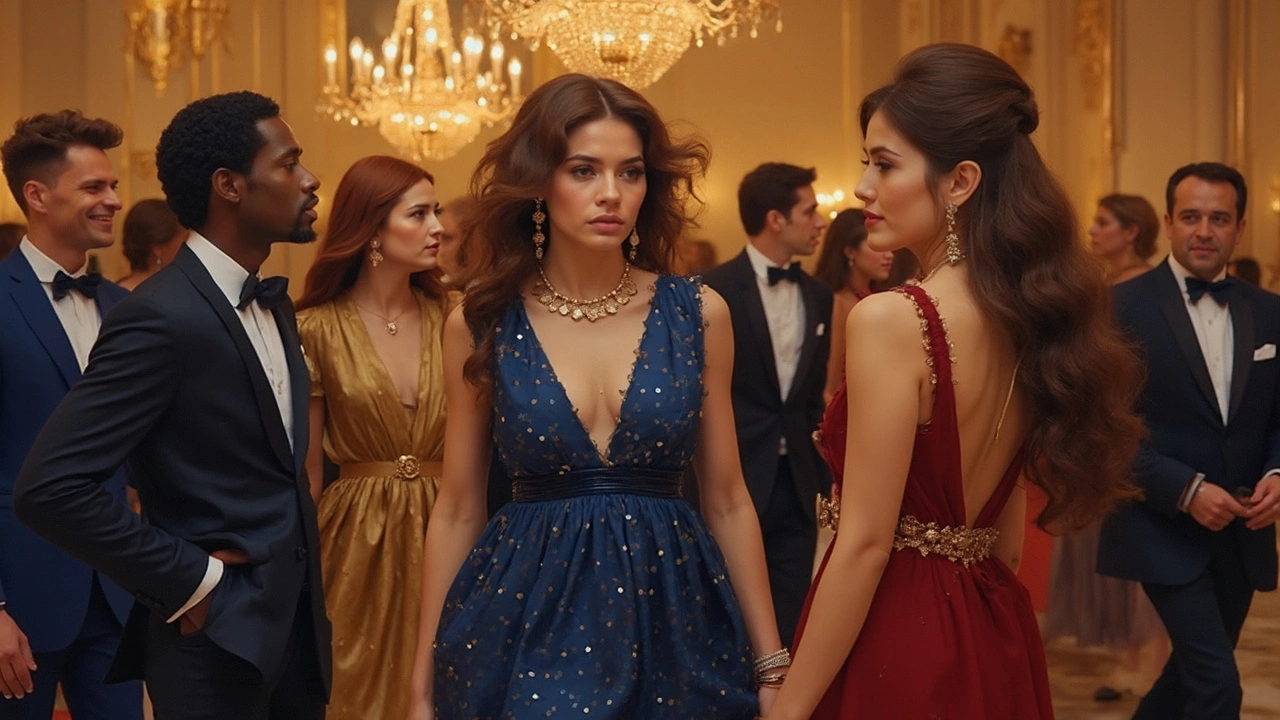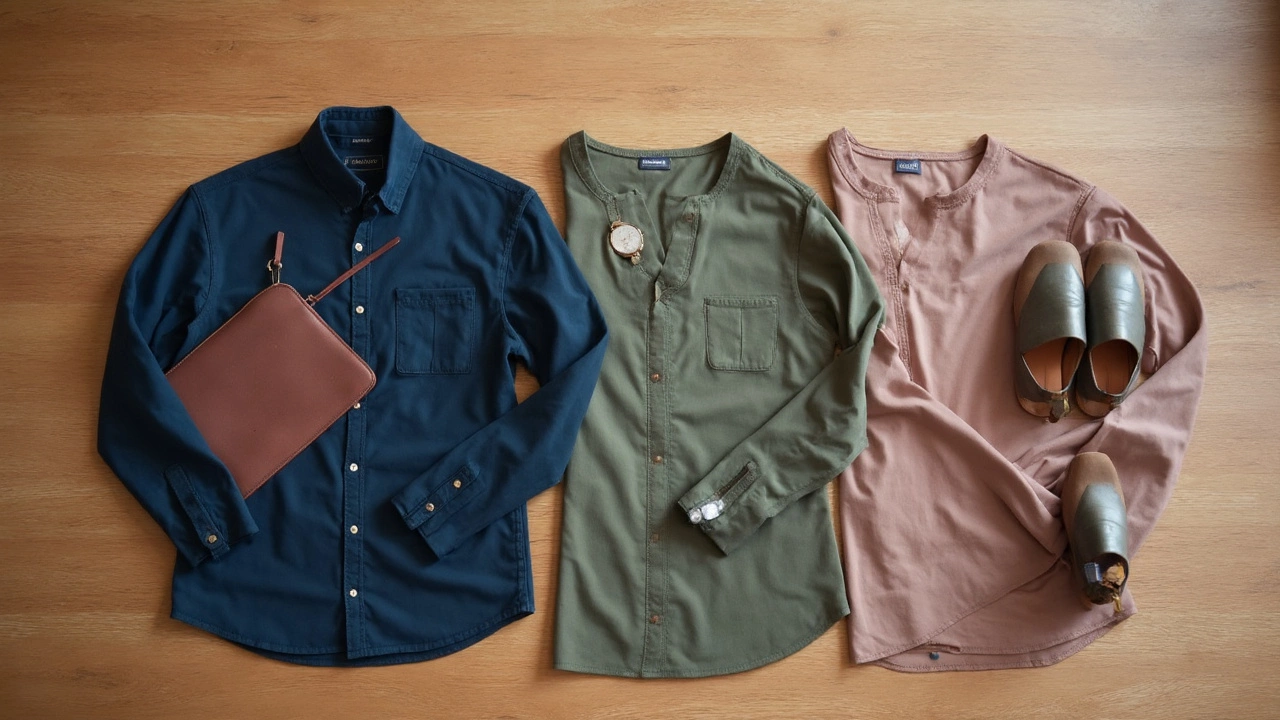Unlocking the Secret: The 3 Color Dress Code

- Cleo Fairchild
- 14 April 2025
- 0 Comments
Ever stood in front of your closet, completely stumped on what to wear for a night out? Enter the 3 color dress code—a simple, yet brilliant rule that can save you from your fashion dilemmas. This strategy is about picking three colors to guide your outfit choices, making your evening look effortlessly chic. Not only does it reduce the chaos of mix-and-match, but it also ensures a cohesive and harmonious appearance.
Wondering why three? It's the magic number in fashion! Three colors strike a balance—neither overwhelming like a rainbow mishmash nor monotonous like a monotone ensemble. Think of it as the Goldilocks of styling: just right. This method not only streamlines your wardrobe decisions but also boosts your confidence knowing you've nailed that polished look.
- Why Three Colors Work
- Choosing the Right Colors
- Accessorizing Smartly
- Balancing Your Look
- Common Mistakes to Avoid
Why Three Colors Work
So, why exactly does the 3 color dress code hit the sweet spot in fashion coordination? Well, it's all about balance and harmony. Using three colors is a straightforward way to create a stylish outfit without the headache of overthinking. The human eye finds odd numbers naturally pleasing, and three is perfect for maintaining an intriguing balance without things getting too busy.
Think about a classic look: a little black dress paired with a silver clutch and red heels. The trio of black, silver, and red is timeless, striking the right chord of elegance and boldness. Unlike a monotone look which can feel flat, or a chaotic mix of too many colors, this rule lets each color shine in its own right.
Fashion experts often recommend this approach when creating prints and patterns, too. Designers use three colors to ensure the pattern captures attention while staying visually harmonious. This principle is not just a random choice but is backed by studies in color theory which show how our brains process and appreciate color groups.
To make this work for your evening dresses, start with one dominant color, then add a secondary color that complements it. Finish with a pop of a third color for interest. For example, a royal blue dress, paired with nude heels, and a splash of gold jewelry.
- Dominant Color: This should cover about 60% of your look. Think of it as the main character of your outfit.
- Secondary Color: This accounts for roughly 30%, providing support without overshadowing.
- Accent Color: The remaining 10%—this is your chance to have fun and add that 'wow' factor!
Next time you’re preparing for a night out, remember less is more. By sticking to this method, you can say goodbye to ensemble anxiety and hello to easy elegance.
Choosing the Right Colors
When it comes to nailing the 3 color dress code, picking the right colors is key. It's all about finding shades that work well together and suit your personal style. A good trick is to start with a base color—something neutral like black, navy, or beige. These colors act as a strong foundation and are super versatile, making it easy to pair with other hues.
Next, think about adding a main color. This should be a shade that stands out and grabs attention without being too overpowering. Look at the color wheel for inspiration—using complementary colors (those opposite each other on the wheel) can really make your outfit pop. For instance, pair a navy base with a striking orange or a deep green with a bright pink.
Your third color should be an accent or highlight. This is where you can have a little fun! Maybe it’s a metallic, a soft pastel, or even a classic white. It adds that extra bit of flair without pulling focus away from the other two colors.
Keep in mind the occasion and your own skin tone when choosing your palette. Slightly darker skin tones might glow with warmer colors, while cooler shades can accentuate lighter skin tones beautifully. Also, consider seasonal trends—perhaps you could incorporate the year’s Pantone color as an accent for a modern touch!
- Base color: Foundation of your outfit. Neutral and versatile.
- Main color: Catchy and complementary. Adds dynamism.
- Accent color: Subtle highlights. Fun and playful.
Once you master this, you'll not only follow this fashion rule but make it your own, giving your outfits that personal flair while keeping things effortlessly stylish.

Accessorizing Smartly
Once you've nailed your three-color palette, it's time to amp up your style with accessories. The trick is to ensure that your accessories complement rather than compete with your evening dress. Here are some handy tips to keep you on point:
Keep it balanced. If your dress is bold and colorful, stick to simpler accessories. On the flip side, a more neutral dress calls for accessories with a pop of color or statement pieces to add some pizzazz. The goal is to avoid clashing patterns or colors, which could overwhelm your look.
Match your metals. If your dress features silver tones, opt for silver or white gold accessories. Gold goes perfect with warmer tones like red or brown dresses. Mixing metals can work but requires a keen eye to ensure cohesion, which might be more of a challenge than sticking to one.
Think about texture. Combining different textures, like adding a satin clutch to a velvet dress, can make your outfit more interesting. But don't go overboard—two or three textures are enough. Coordinating textures adds depth to your look while keeping the focus on the dress.
- Belts: A nice belt can amplify your waist and add structure, especially if the dress is a little loose.
- Shoes: They don't just need to match; they need to suit the occasion's formality level, too. Heels can turn a comfy dress into a chic outfit.
- Handbags: Stick with clutches or small bags for evening occasions—they're more appropriate and less bulky than larger bags.
And here's a little bonus tip: When in doubt, less is more. It's better to have one or two standout pieces—like a bold necklace or stunning earrings—than try to load up with all the bling you have. Accessories should enhance your look, not overpower it. By accessorizing smartly, you can create a seamless and stylish ensemble that's fit for any evening event.
Balancing Your Look
So, you've got your 3 color dress code figured out, and now it’s all about pulling it together for a balanced look. The secret? It's in the distribution of colors and how they complement each other.
Start by deciding the dominant color. This will make up about 60% of your outfit—think of it as the star of the show. It could be the color of your evening dresses or a statement piece like a coat or blazer. Your secondary color should fill around 30% of your look, offering a nice contrast or complementing the main shade. This could be your top or bottom, depending on what you’re working with. Finally, the accent color is where you can have a bit of fun. It should cover about 10% of your outfit and can come in the form of accessories like bags, shoes, or jewelry.
Keeping these proportions in mind makes your entire ensemble look intentional and well thought-out. Here's a simple breakdown:
- 60% Dominant Color: Choose your main piece, like an elegant navy dress for a classic night out.
- 30% Secondary Color: Add depth with a contrasting or complementary shade, like a silver clutch.
- 10% Accent Color: Finish with pops of color, maybe a bold red lipstick or bright shoes.
It doesn't stop there; consider the textures and patterns. Mixing them across different items can create visual interest without overwhelming the senses. For instance, a velvet dress can look gorgeous paired with metallic accessories, adding depth to your fashion ensemble.
Finally, don't underestimate the power of neutrals. They often serve as 'color buffers' and can be used to balance stronger colors. Whites, blacks, and greys work wonders to refine and polish your look, ensuring you don’t just follow the rule but own your style.

Common Mistakes to Avoid
Even with a stylish 3 color dress code, it's easy to misstep and lose that sleek, polished vibe. Knowing what to skip is just as vital as knowing what to do. Let's talk about some missteps you might want to dodge to master your evening look.
First off, be cautious with the shades you pick. All three colors should complement each other. The trap here is mixing tones that fight for attention or clash outright. If one color is bright, like a vibrant red, balance it with a neutral like beige or black, so you’re not a walking kaleidoscope.
Avoid overloading on accessories within those three colors. Accessories should enhance, not overwhelm. Keep it simple. Too many bracelets, necklaces, or flashy hats can make things messy. If your dress is a bold color, perhaps tone it down with minimalist jewelry.
Patterns and prints can trip you up too. Mixing too many can ruin the cohesion. So, if your dress features a pattern, use solids for your other two colors. This keeps the focus where it should be—on you, not the fabric.
Finally, skimping on fabric quality can be a bummer. Even if your colors are on point, cheap materials can ruin the entire look. Invest in quality fabrics—they flow better, hold up longer, and make colors appear richer.
A stylish example: Pair a navy evening dress (blue) with silver heels (metallic) and a cream clutch (neutral). Simple, sophisticated, and no fashion faux pas in sight!


